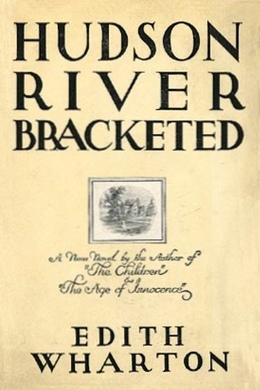The Thundertop picnic at sunrise over the Hudson River is the first of two picnics in Wharton’s Hudson River Bracketed. The other is a honeymoon picnic on an ocean beach, which I’ve treated in a separate posting. Both picnics are extended metaphors for Vance Weston’s romantic relationships and emotional entanglements that never quite work out.
The Thundertop Mountain picnic is the first “date” for Weston and Halo Spear. It promises well, but too many miscues suggest their relationship will fizzle. For instance, the trip up Thundertop is shaky because Spear’s motorcar is always on the verge of stalling. Socially, Weston and Spear are mismatched. Weston is timid, relatively uneducated, and middle class; Spear is effusive (cheeky) and assertive (at least with Vance), educated, and upper class. Most of what Spear chatters about is incomprehensible to Weston, but he plays along.

Edith Wharton. Hudson River Bracketed. New York: D. Appleton and Company, 1929. This is the first edition cover.
The sunrise, Wharton describes, is spectacular. They watched . . . the forerunning glow burns away the ashen blur in the forest hollows, the upper sky whitens, and daylight takes possession of the air. Again they turned westward, looking toward the Hudson, and now the tawny suffusion was drawing down the slopes of the farther shore, till gradually, very gradually, the river hollows also were washed off their mists, and the great expanse of the river shone bright as steel in the clear shadow.
But when the sun is up, the picnic goes wrong. Spear is hungry: “Come along, Vance! I’m ravening. Ham and eggs over a gypsy fire!” She slipped a comrade-arm through his, and they started to scramble down from their eminence, leaving at each step a fragment of the mighty spectacle behind them. Vance, reluctantly following, thought to himself: “She never stays anywhere more than five minutes—” However, the breakfast fails because neither can light a campfire. They eat raw eggs and ham on stale bread. Fortunately, the coffee is packed in a thermos, but this is not enough to keep a nascent romance “hot.”
During the descent, the “motor” breaks down—a metaphor for Vance and Halo’s nascent romance. Though long after Spear and Weston are periodically reminded of the sunrise, the breakfast, and the gypsy fire the memory, neither recognizes that this is a sign that they are in love. Even afterward, Vance doesn’t get it. And “in looking back at the adventure, he wondered at the fact that he had hardly been conscious of his companion’s age or sex, hardly aware of the grave beauty of her face, had felt her only as the mysterious vehicle of all the new sensations pouring into his soul–as if she had been the element harmonizing the scene, or a being born of the sunrise and the forest.” Halo is perplexed, and when she is “Waking near noon that day from the sleep into which she had fallen after the vigil on Thundertop, Héloïse [Halo] Spear sat up in bed and thought: “What’s wrong?”
However, nothing substantial comes of it. Halo marries a man she does not love for money and social prestige; Vance wanders until he meets and marries an ordinary sweet woman he does not deeply love. Spear and Weston do not seriously engage in romance until Wharton’s sequel The Gods Arrive (1932).
* Thundertop Mountain is probably Dunderberg, which means Thunder Mountain in Dutch. It’s a low hill, about 1000feet high, on the Hudson’s west side in Bear Mountain State Park. The picnic is situated above the fictional town of Paul’s Landing is probably Rhinebeck or Rhinecliff, on the eastern shore.
See Edith Wharton. Hudson River Bracketed. New York: D. Appleton and Company, !929; Cecilia Macheski. “In the Lands of Garlic and Queer Bearded Sea-Things: Appetites and Allusions in the Fiction of Edith Wharton.” In Cooking by the Book: Food in Literature and Culture, edited by Mary Anne Schofield. Bowling Green, Ohio: Bowling Green University Press, 1989.
See Edith Wharton. Hudson River Bracketed. New York: D. Appleton and Company,
1929; Cecilia Macheski. “In the Lands of Garlic and Queer Bearded Sea-Things: Appetites and Allusions in the Fiction of Edith Wharton.” In Cooking by the Book: Food in Literature and Culture, edited by Mary Anne Schofield. Bowling Green, Ohio: Bowling Green University Press, 1989.

